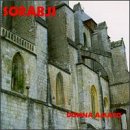| All Artists: Kaikhosru Sorabji, Donna Amato Title: Sorabji: Piano Works Members Wishing: 1 Total Copies: 0 Label: Altarus Release Date: 10/20/1995 Genres: Special Interest, Classical Style: Number of Discs: 1 SwapaCD Credits: 1 UPC: 076958702525 |
Search - Kaikhosru Sorabji, Donna Amato :: Sorabji: Piano Works
 | Kaikhosru Sorabji, Donna Amato Sorabji: Piano Works Genres: Special Interest, Classical
|
Larger Image |
CD Details |
CD ReviewsAmato is wonderful with Sorabji's density intensity scarecrow | Chicago, Illinois United States | 04/23/2000 (5 out of 5 stars) "These are wonderfully grotesque pieces,with expressive immensity,unrelenting. The first two works are based on ghost stories by writer Montague Rhodes who wrote in this genre to escape the boredom of academia. Sorabji uses these stories at a great conceptual distance, he never tone paints, all of Sorabji, at least whatever I've heard recorded, does not transform a text or image into a sonic representation the way Richard Strauss.But the piano sonorities do suggest this,like the two-handed organ-like chords for the cathedral settings here of St.Bertrand. Quaere reliqua hujus materiei is unrelenting scouring the entire register of the piano,fast arpeggiated momnets,highlt ornamented textures,sounding improvisational most of the time. Sorabji has also contributed greatly toward blurring the tyranny of the barline,but then that's not saying much for all of Sorabji has similar expressive features. Amato plays the hell out of these pieces, and you need always to clarify your playing,the way chords are shaped and articulated, the sonority must always be clean with a transparency of tone. Sorabji's music is incredibly dense with continuous motion. The pianist who ventures to play Sorabji is like a small boat at sea during a formidable storm,swaying, rocking and diving in between and amongst the rolling dangerous waves. Likewise St Bertrand de Comminges, where a skull decoration is included within the notes here from the sixteenth century cathedral the piece depicts. Busoni has left an indelible mark on Sorabji's creativity,having heard him when Sorabji was very young, for which in return we cannot help but hear Busoni in Sorabji's music. Nothing obvious except here as Sorabji's utilization of a quote from Busoni's opera Arlecchino,which was an anti-war response to the First World War. Passeggiata arlecchinesca amply transforms the excerpt Passiagiata derived from Passacaglia uses this melodic quote as as tructural base. Recall that Busoni was also a great transformer of music materials himself, he overhauled the tradition began by Listz(actually arrangements have always been an integral part of music's content in history)For Busoni however we have his Chaconne for piano transmografied from the Bach violin piece as a high water mark in this genre. Sorabji's musical language has similar features as Busoni throughout all his works,the density, the intense expression,engaging the piano sound for the sheer joy of its roaring demeanor,texture, and contrasting colour of brooding octaves to higher register bell-like moments, so the Arlecchino is barely recognized.,yet transformed all the same. Written in January 1982 this was possibly Sorabji's last work."
|

 Track Listings (6) - Disc #1
Track Listings (6) - Disc #1